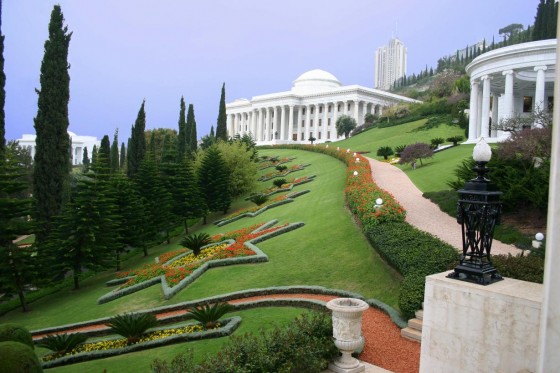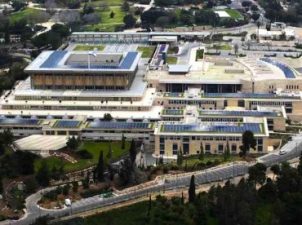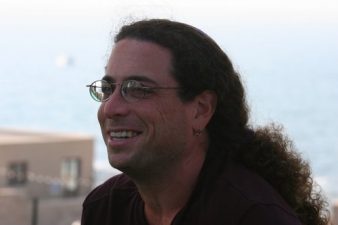 Members of the often persecuted Bahai faith are inherently green.
Members of the often persecuted Bahai faith are inherently green.
The terrace of the Baha’i Shrine and Gardens in Haifa is the most stunning destination in Israel’s third largest city. From the eastern side of the city, along the popular route 4, you first catch glimpse of it rising up towards the sky on your left. An expansive swath of green lawn manicured in layers and flanked by date trees span the height of the northern end of the Carmel mountainside. Year round and from a distance, the vision quite literally draws your gaze towards the impressive site, “a geometric cascade of hanging gardens and terraces down to Ben Gurion Boulevard -a gift of visual pleasure to the city that gave the Baha’i religion its home and headquarters.”
Baha’i Tourism
The Haifa-Akko corridor of Israel is the international headquarters of the Baha’i faith, a modern religion that traces its roots in mid-19th century Persia. Technically called the Baha’i World Centre, these famous gardens were designed by architect Fariborz Shabha and completed in 2001. The huge domed shrine in the center of the hillside is spectacular and ornamental, just one of the main structures here that houses the tomb of the Baha’i faith founder and administrative offices. Three years ago, UNESCO named the shrine a World Heritage Site.
As a visual symbol of unity, a central precept to the religion, the structures incorporate western and eastern design elements. “The granite columns recall classic Roman architecture, the Corinthian capitals are reminiscent of ancient Greece, and the arches add the flavor of the Orient. On a higher hilltop stands the Corinthian-style Baha’i International Archives building, modeled after the Parthenon, and the Baha’i Universal House of Justice, with 58 marble columns and hanging gardens,” explains the official website.
The gardens and shrine are a popular tourist destination in Israel. I first heard of the site in 2008, during my third visit to Israel. When we moved to the Galil in 2009, my curiosity about this spiritual haven for a faith other than the three major religions in Israel was inextricably was piqued.
Baha’i Prosecutions
Though they do not describe themselves as an Abrahamic religion, in many Islamic countries Baha’i believers are often considered as apostates of the Muslim Faith, and several hundred have been executed. Baha’i experience continued persecution in parts of the Middle East including Egypt and Iran, where this modern independent religion, the second fastest growing in the world by percentage, was birthed in the 1800s. Religious restrictions continue in places like Afghanistan, Algeria, Indonesia and sub-Saharan Africa, though India is home to the largest segment. 2.2 of the 6-7 million worldwide live in India, with followers in over 200 countries.
Recently, Israeli Baha’i followers were charged as Zionist spies by the Iranian government, their story making the front page of international news agencies.
The relationship to Israel goes back to the time of the Ottoman rule, when the religious leader and co-founder of the faith, Bahá’u’lláh (1817 – 1892), was banished to Akko by the Turks. His spiritual predecessor, Siyyid `Alí-Muhammad, who took the title, Báb (which means gate in Arabic), had been executive in their native Persia in 1850. Despite over 20 years of banishment in Israel, Bahá’u’lláh and his followers established a flourishing spiritual community. Today their presence in Israel is obvious to residence and visitors to northern Israel, particularly during the springtime, which coincides with the Baha’i celebration of their calendar New Year (March 21, the Spring equinox).
Baha’i Traditions
The nineteen days preceding this date is observed by prayer, meditation and fasting from sunrise to sunset. Another important celebration, the holiest of holidays, is the Festival of Ridvan (April 21-May 2). This annual Baha’i festival commemorates the twelve days when Baha’u’llah resided in a garden called Ridvan (Paradise) in Baghdad, Iraq. At this time their leader publicly proclaimed his mission as a messenger of God for this age. All work is suspended during this holiday.
In many ways, this Baha’i religion is like the fourth faith in Israel, steeped in historical, albeit modern by this region’ standards, and religious meaning. Like their Jewish, Christian and Muslim counterparts, the Baha’i followers are connected and find refuge in the land, and sometimes they suffer for it as well.
Even the remains of the Bab were eventually smuggled out of Iran and brought to their final resting place in the hills of Akko, solidifying Israel as the world center for the Baha’i Faith.
Baha’i Sustainability
By first impression they have carved their niche with an emphasis on worldwide religious harmony, a feeling one gets in spades when viewing their gardens. “Baha’is believe in the unity of all religions and believe that messengers of God like Moses, Jesus and Muhammad have been sent at different times in history with doctrines varying to fit changing social needs, but bringing substantially the same message.”
According to the teachings of this monotheistic philosophy, humanity is one single race and that the day has come for its unification in one global society. “God, Bahá’u’lláh said, has set in motion historical forces that are breaking down traditional barriers of race, class, creed, and nation and that will, in time, give birth to a universal civilization. The principal challenge facing the peoples of the earth is to accept the fact of their oneness and to assist the processes of unification.”
Baha’i Social Action
To this end, the Baha’i collaborate with many global organizations including some UN agencies such as the United Nations Children’s Fund (UNICEF), the United Nations Development Fund for Women (UNIFEM); the United Nations Development Program (UNDP); and the United Nations Fund for Population Activities (UNFPA).
Social action, particularly with regards to the advancement of women, takes center stage. In 1985 for example, their governing body, called the Universal House of Justice, released a statement of peace that included the following:
“The emancipation of women, the achievement of full equality between the sexes, is one of the most important, though less acknowledged prerequisites of peace. The denial of such equality perpetrates an injustice against one half of the world’s population and promotes in men harmful attitudes and habits that are carried from the family to the workplace, to political life, and ultimately to international relations. There are no grounds, moral, practical, or biological, upon which such denial can be justified. Only as women are welcomed into full partnership in all fields of human endeavor will the moral and psychological climate be created in which international peace can emerge.”
This idea of unity and social harmony for all members of the human race is a goal that often feels unattainable in this nook of the globe. And yet, when one wanders along the terraced hillside, rolling down from top to bottom of Mt. Carmel in Haifa like a green magic carpet, one feels the pulse of something grander than war and conflict. Here, peace and calm prevail for the half million yearly visitors who schedule a tour.
These Hanging Gardens of Haifa, another name for the grounds, are steeped in beauty and meaning. All religions have esoteric messages in their designs and language, and this place is no exception. Nine terraces above, and 9 below the Shrine of the Bab represent his first 18 disciples. And eighteen, as most of us know, is the number that represents life, l‘chaim!
Interested visitors can contact the Baha’i gardens at http://www.ganbahai.org.il/en/
Read More News:
Full Frontal Exposure: World Reacts to Naked Israelis
Saudi Spring For Women Drivers




Wonderful article! I especially liked the last sentence, which was new information to me: “And eighteen, as most of us know, is the number that represents life, l‘chaim!” Fantastic!
I think the Bahai faith as an integration of many, can teach us a lot about understanding the other.
Good article